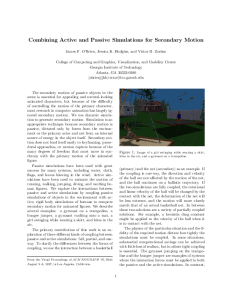Combining Active and Passive Simulations for Secondary Motion
Abstract
The secondary motion of passive objects in the scene is essential for appealing and natural-looking animated characters, but because of the difficulty of controlling the motion of the primary character, most research in computer animation has largely ignored secondary motion. We use dynamic simulation to generate secondary motion. Simulation is an appropriate technique because secondary motion is passive, dictated only by forces from the environment or the primary actor and not from an internal source of energy in the object itself. Secondary motion does not lend itself easily to keyframing, procedural approaches, or motion capture because of the many degrees of freedom that must move in synchrony with the primary motion of the animated figure.
Citation
James F. O'Brien, Victor B. Zordan, and Jessica K. Hodgins. "Combining Active and Passive Simulations for Secondary Motion". In Proceedings of SIGGRAPH 1997, Technical Sketch, July 1997.
Supplemental Material
Full Paper
The full version of this paper was published in IEEE: Computer Graphics and Applications.









